Construction Work Safety: A Case Study of a Crane Operator in Melbourne Who Was Killed in a Fall
VerifiedAdded on 2022/12/20
|11
|3157
|1
AI Summary
This case study examines a crane-related accident in Melbourne, Australia, where a crane operator fell 35m and died. It analyzes the incident, explores the root causes of crane-related accidents, and provides recommendations for safety measures in construction sites. The study concludes with the importance of investigating the root cause of accidents to prevent future deaths in the construction industry.
Contribute Materials
Your contribution can guide someone’s learning journey. Share your
documents today.
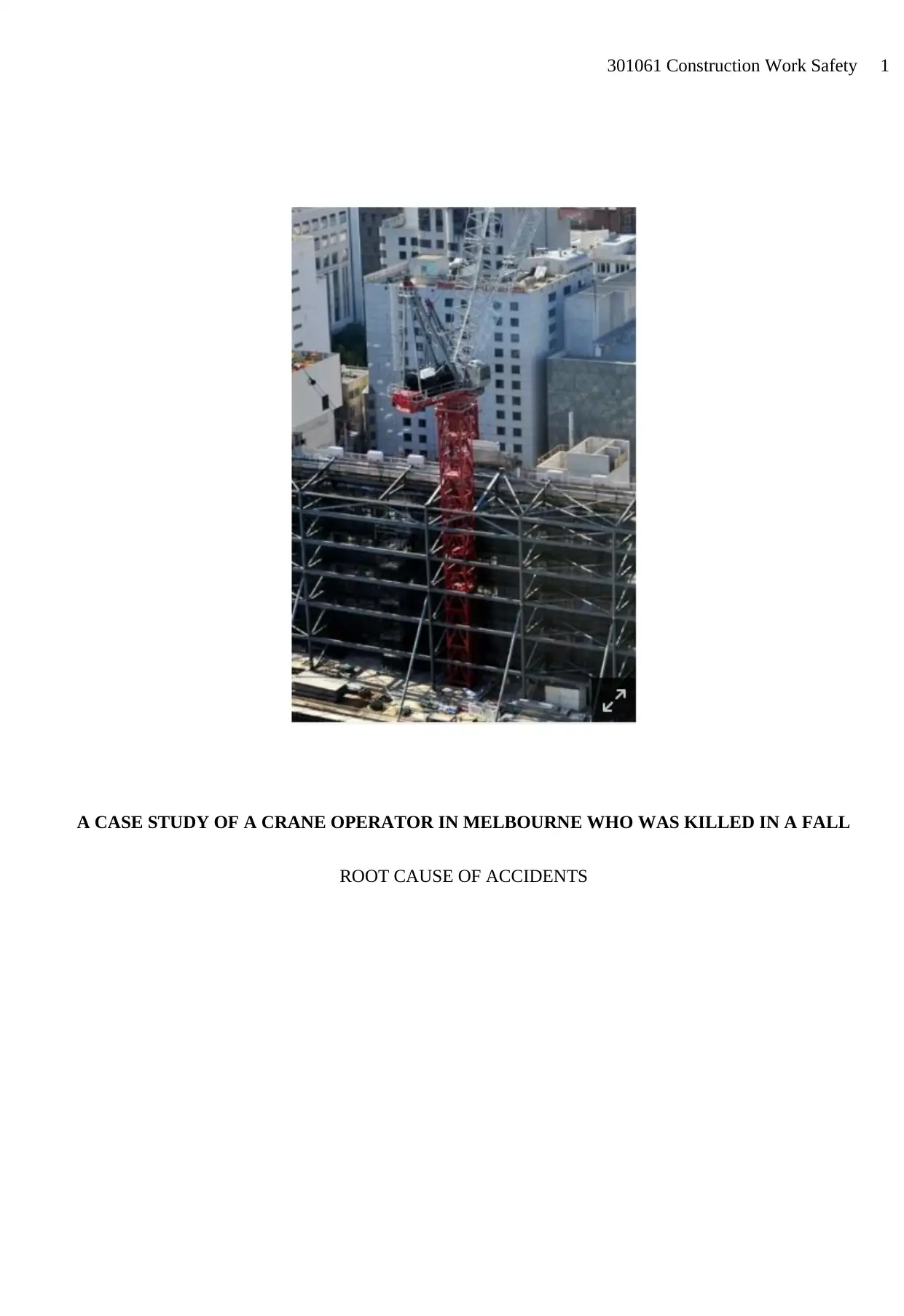
301061 Construction Work Safety 1
A CASE STUDY OF A CRANE OPERATOR IN MELBOURNE WHO WAS KILLED IN A FALL
ROOT CAUSE OF ACCIDENTS
A CASE STUDY OF A CRANE OPERATOR IN MELBOURNE WHO WAS KILLED IN A FALL
ROOT CAUSE OF ACCIDENTS
Secure Best Marks with AI Grader
Need help grading? Try our AI Grader for instant feedback on your assignments.
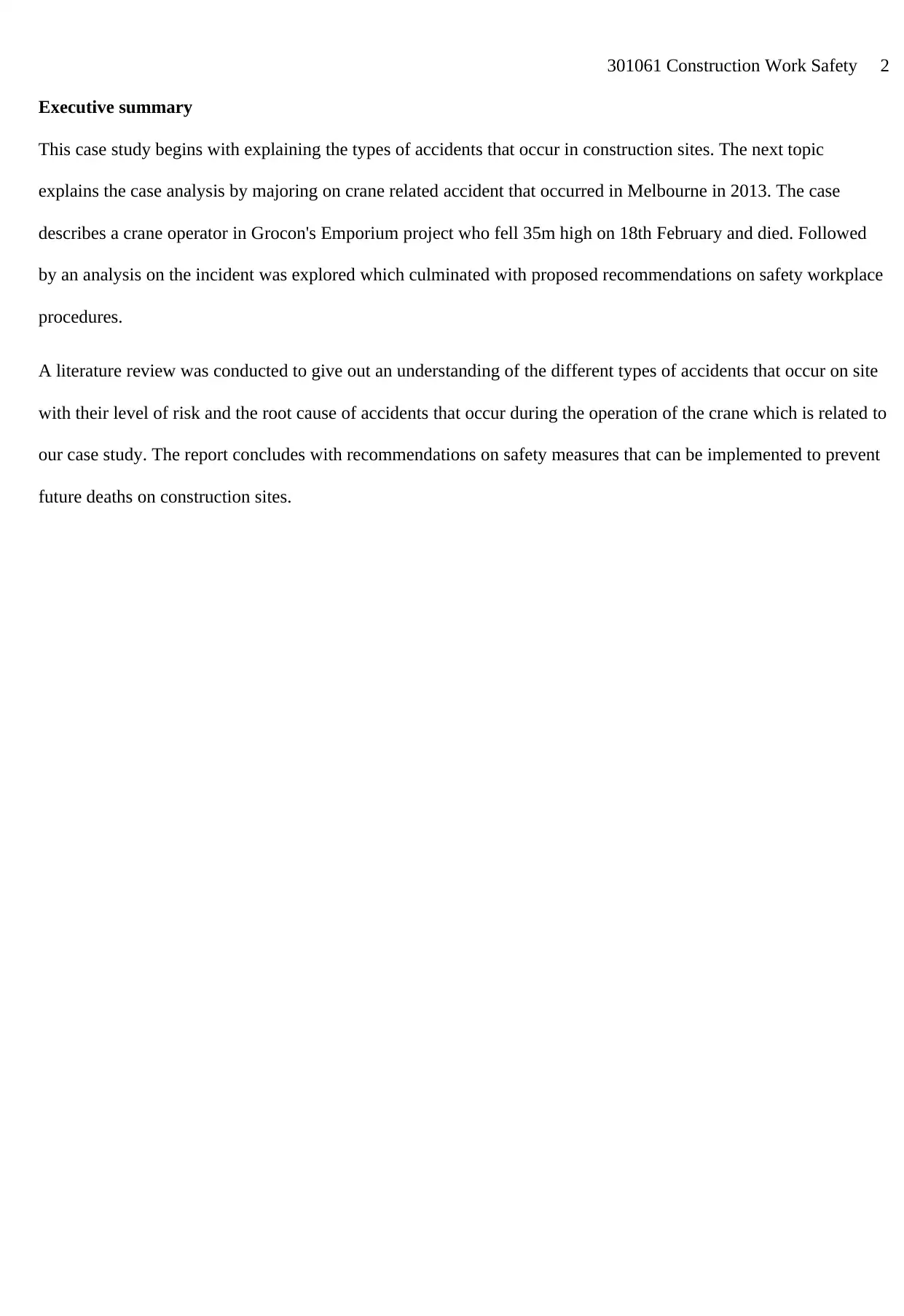
301061 Construction Work Safety 2
Executive summary
This case study begins with explaining the types of accidents that occur in construction sites. The next topic
explains the case analysis by majoring on crane related accident that occurred in Melbourne in 2013. The case
describes a crane operator in Grocon's Emporium project who fell 35m high on 18th February and died. Followed
by an analysis on the incident was explored which culminated with proposed recommendations on safety workplace
procedures.
A literature review was conducted to give out an understanding of the different types of accidents that occur on site
with their level of risk and the root cause of accidents that occur during the operation of the crane which is related to
our case study. The report concludes with recommendations on safety measures that can be implemented to prevent
future deaths on construction sites.
Executive summary
This case study begins with explaining the types of accidents that occur in construction sites. The next topic
explains the case analysis by majoring on crane related accident that occurred in Melbourne in 2013. The case
describes a crane operator in Grocon's Emporium project who fell 35m high on 18th February and died. Followed
by an analysis on the incident was explored which culminated with proposed recommendations on safety workplace
procedures.
A literature review was conducted to give out an understanding of the different types of accidents that occur on site
with their level of risk and the root cause of accidents that occur during the operation of the crane which is related to
our case study. The report concludes with recommendations on safety measures that can be implemented to prevent
future deaths on construction sites.
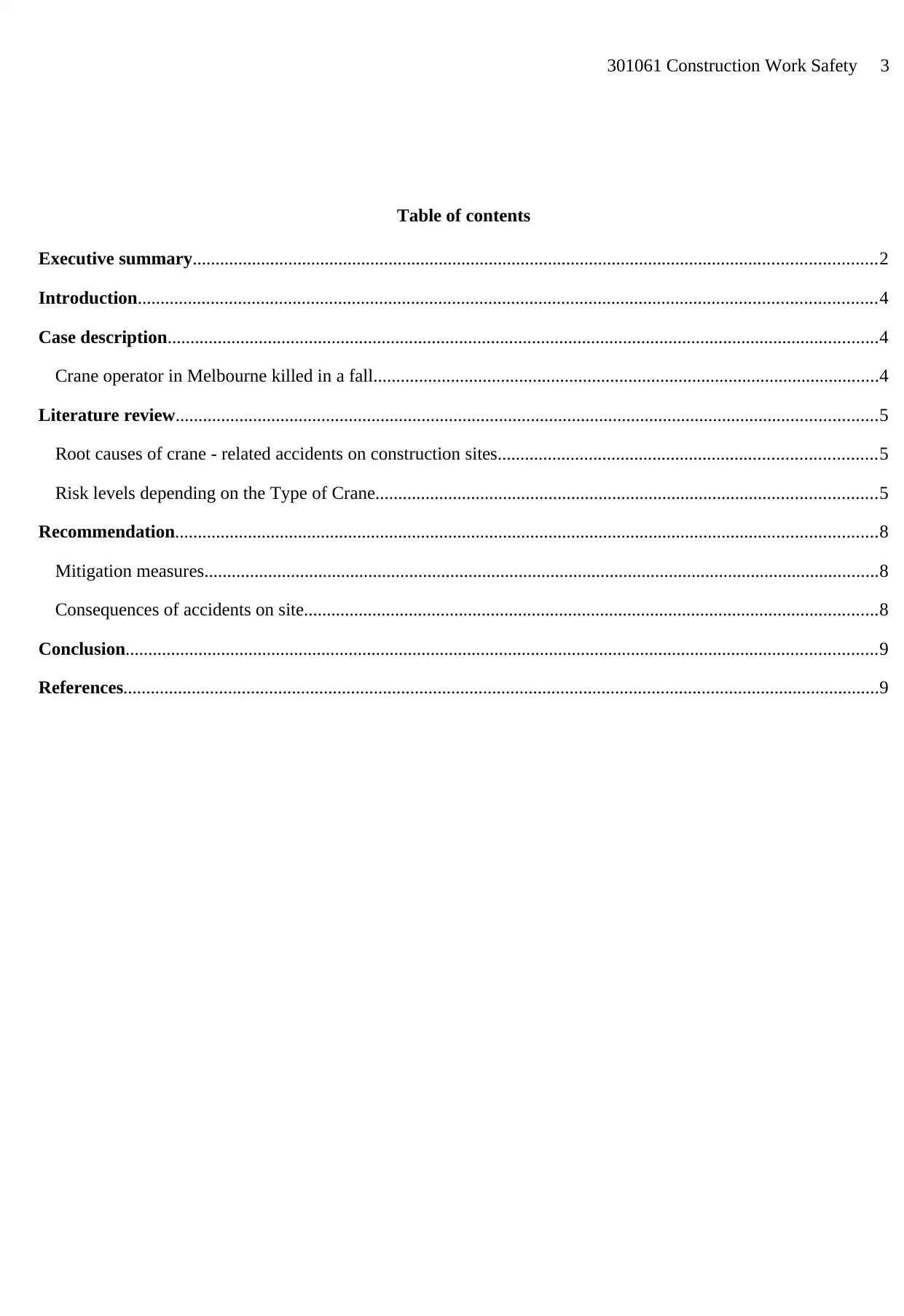
301061 Construction Work Safety 3
Table of contents
Executive summary......................................................................................................................................................2
Introduction..................................................................................................................................................................4
Case description............................................................................................................................................................4
Crane operator in Melbourne killed in a fall...............................................................................................................4
Literature review..........................................................................................................................................................5
Root causes of crane - related accidents on construction sites...................................................................................5
Risk levels depending on the Type of Crane..............................................................................................................5
Recommendation..........................................................................................................................................................8
Mitigation measures....................................................................................................................................................8
Consequences of accidents on site..............................................................................................................................8
Conclusion.....................................................................................................................................................................9
References......................................................................................................................................................................9
Table of contents
Executive summary......................................................................................................................................................2
Introduction..................................................................................................................................................................4
Case description............................................................................................................................................................4
Crane operator in Melbourne killed in a fall...............................................................................................................4
Literature review..........................................................................................................................................................5
Root causes of crane - related accidents on construction sites...................................................................................5
Risk levels depending on the Type of Crane..............................................................................................................5
Recommendation..........................................................................................................................................................8
Mitigation measures....................................................................................................................................................8
Consequences of accidents on site..............................................................................................................................8
Conclusion.....................................................................................................................................................................9
References......................................................................................................................................................................9
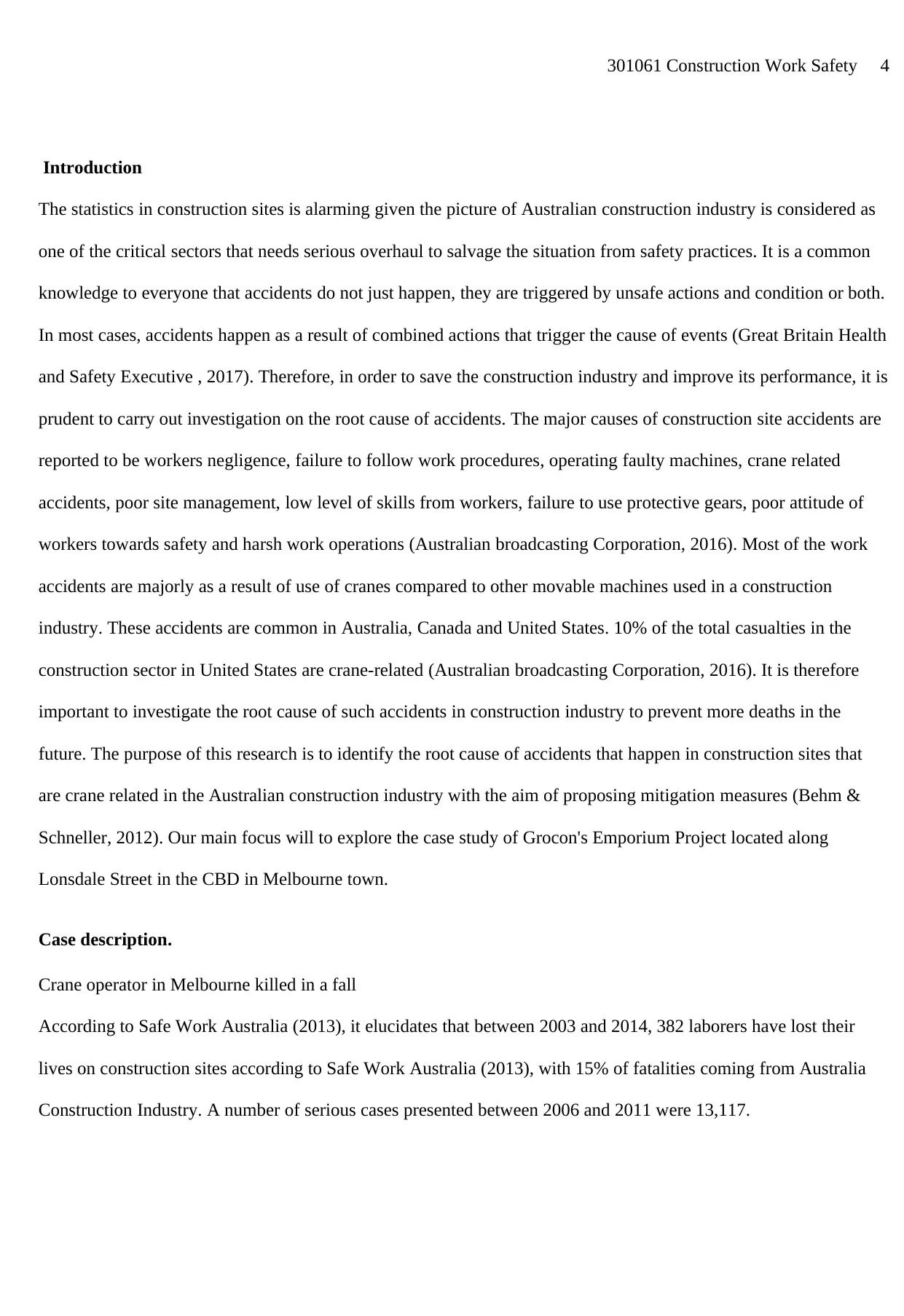
301061 Construction Work Safety 4
Introduction
The statistics in construction sites is alarming given the picture of Australian construction industry is considered as
one of the critical sectors that needs serious overhaul to salvage the situation from safety practices. It is a common
knowledge to everyone that accidents do not just happen, they are triggered by unsafe actions and condition or both.
In most cases, accidents happen as a result of combined actions that trigger the cause of events (Great Britain Health
and Safety Executive , 2017). Therefore, in order to save the construction industry and improve its performance, it is
prudent to carry out investigation on the root cause of accidents. The major causes of construction site accidents are
reported to be workers negligence, failure to follow work procedures, operating faulty machines, crane related
accidents, poor site management, low level of skills from workers, failure to use protective gears, poor attitude of
workers towards safety and harsh work operations (Australian broadcasting Corporation, 2016). Most of the work
accidents are majorly as a result of use of cranes compared to other movable machines used in a construction
industry. These accidents are common in Australia, Canada and United States. 10% of the total casualties in the
construction sector in United States are crane-related (Australian broadcasting Corporation, 2016). It is therefore
important to investigate the root cause of such accidents in construction industry to prevent more deaths in the
future. The purpose of this research is to identify the root cause of accidents that happen in construction sites that
are crane related in the Australian construction industry with the aim of proposing mitigation measures (Behm &
Schneller, 2012). Our main focus will to explore the case study of Grocon's Emporium Project located along
Lonsdale Street in the CBD in Melbourne town.
Case description.
Crane operator in Melbourne killed in a fall
According to Safe Work Australia (2013), it elucidates that between 2003 and 2014, 382 laborers have lost their
lives on construction sites according to Safe Work Australia (2013), with 15% of fatalities coming from Australia
Construction Industry. A number of serious cases presented between 2006 and 2011 were 13,117.
Introduction
The statistics in construction sites is alarming given the picture of Australian construction industry is considered as
one of the critical sectors that needs serious overhaul to salvage the situation from safety practices. It is a common
knowledge to everyone that accidents do not just happen, they are triggered by unsafe actions and condition or both.
In most cases, accidents happen as a result of combined actions that trigger the cause of events (Great Britain Health
and Safety Executive , 2017). Therefore, in order to save the construction industry and improve its performance, it is
prudent to carry out investigation on the root cause of accidents. The major causes of construction site accidents are
reported to be workers negligence, failure to follow work procedures, operating faulty machines, crane related
accidents, poor site management, low level of skills from workers, failure to use protective gears, poor attitude of
workers towards safety and harsh work operations (Australian broadcasting Corporation, 2016). Most of the work
accidents are majorly as a result of use of cranes compared to other movable machines used in a construction
industry. These accidents are common in Australia, Canada and United States. 10% of the total casualties in the
construction sector in United States are crane-related (Australian broadcasting Corporation, 2016). It is therefore
important to investigate the root cause of such accidents in construction industry to prevent more deaths in the
future. The purpose of this research is to identify the root cause of accidents that happen in construction sites that
are crane related in the Australian construction industry with the aim of proposing mitigation measures (Behm &
Schneller, 2012). Our main focus will to explore the case study of Grocon's Emporium Project located along
Lonsdale Street in the CBD in Melbourne town.
Case description.
Crane operator in Melbourne killed in a fall
According to Safe Work Australia (2013), it elucidates that between 2003 and 2014, 382 laborers have lost their
lives on construction sites according to Safe Work Australia (2013), with 15% of fatalities coming from Australia
Construction Industry. A number of serious cases presented between 2006 and 2011 were 13,117.
Secure Best Marks with AI Grader
Need help grading? Try our AI Grader for instant feedback on your assignments.
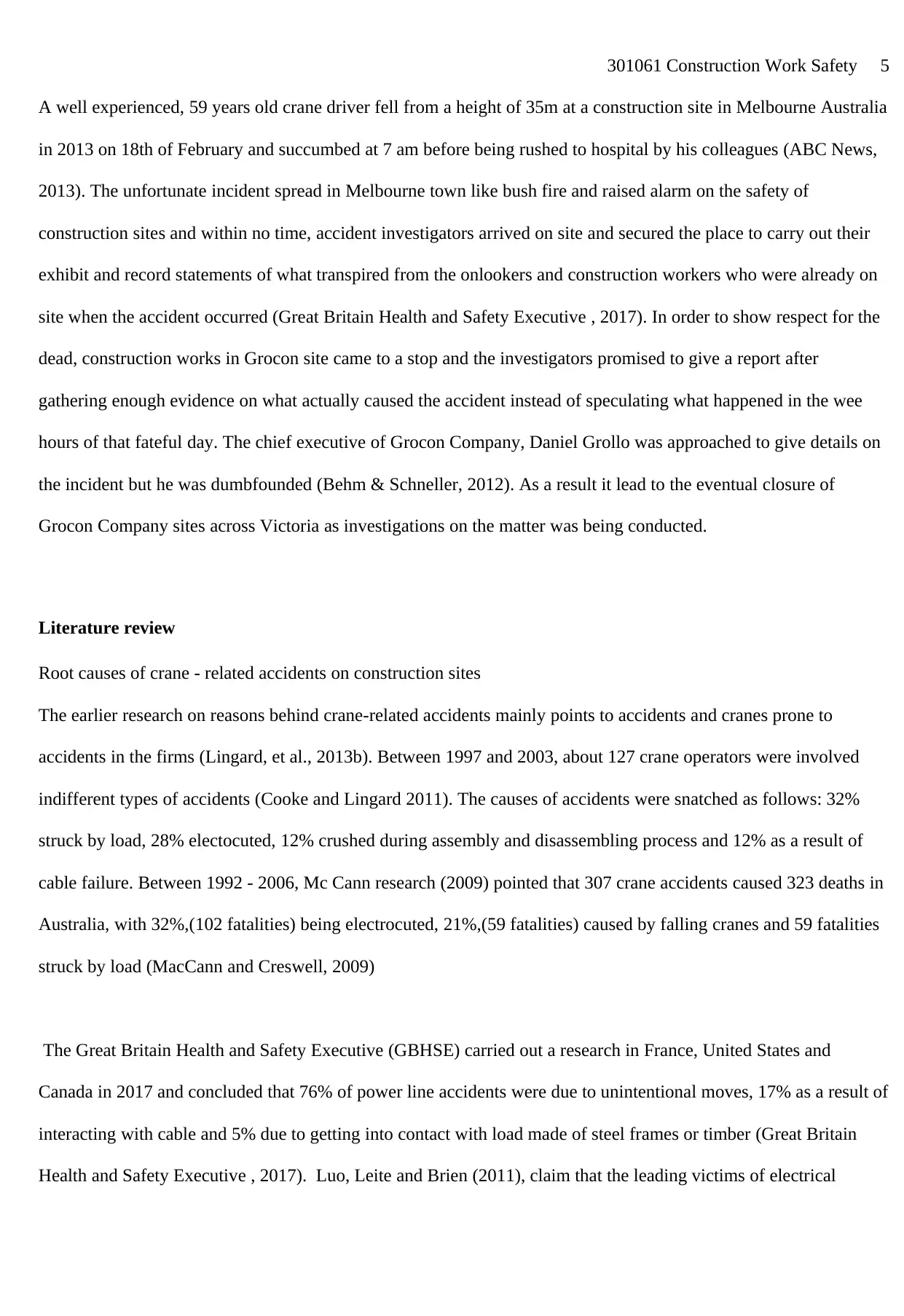
301061 Construction Work Safety 5
A well experienced, 59 years old crane driver fell from a height of 35m at a construction site in Melbourne Australia
in 2013 on 18th of February and succumbed at 7 am before being rushed to hospital by his colleagues (ABC News,
2013). The unfortunate incident spread in Melbourne town like bush fire and raised alarm on the safety of
construction sites and within no time, accident investigators arrived on site and secured the place to carry out their
exhibit and record statements of what transpired from the onlookers and construction workers who were already on
site when the accident occurred (Great Britain Health and Safety Executive , 2017). In order to show respect for the
dead, construction works in Grocon site came to a stop and the investigators promised to give a report after
gathering enough evidence on what actually caused the accident instead of speculating what happened in the wee
hours of that fateful day. The chief executive of Grocon Company, Daniel Grollo was approached to give details on
the incident but he was dumbfounded (Behm & Schneller, 2012). As a result it lead to the eventual closure of
Grocon Company sites across Victoria as investigations on the matter was being conducted.
Literature review
Root causes of crane - related accidents on construction sites
The earlier research on reasons behind crane-related accidents mainly points to accidents and cranes prone to
accidents in the firms (Lingard, et al., 2013b). Between 1997 and 2003, about 127 crane operators were involved
indifferent types of accidents (Cooke and Lingard 2011). The causes of accidents were snatched as follows: 32%
struck by load, 28% electocuted, 12% crushed during assembly and disassembling process and 12% as a result of
cable failure. Between 1992 - 2006, Mc Cann research (2009) pointed that 307 crane accidents caused 323 deaths in
Australia, with 32%,(102 fatalities) being electrocuted, 21%,(59 fatalities) caused by falling cranes and 59 fatalities
struck by load (MacCann and Creswell, 2009)
The Great Britain Health and Safety Executive (GBHSE) carried out a research in France, United States and
Canada in 2017 and concluded that 76% of power line accidents were due to unintentional moves, 17% as a result of
interacting with cable and 5% due to getting into contact with load made of steel frames or timber (Great Britain
Health and Safety Executive , 2017). Luo, Leite and Brien (2011), claim that the leading victims of electrical
A well experienced, 59 years old crane driver fell from a height of 35m at a construction site in Melbourne Australia
in 2013 on 18th of February and succumbed at 7 am before being rushed to hospital by his colleagues (ABC News,
2013). The unfortunate incident spread in Melbourne town like bush fire and raised alarm on the safety of
construction sites and within no time, accident investigators arrived on site and secured the place to carry out their
exhibit and record statements of what transpired from the onlookers and construction workers who were already on
site when the accident occurred (Great Britain Health and Safety Executive , 2017). In order to show respect for the
dead, construction works in Grocon site came to a stop and the investigators promised to give a report after
gathering enough evidence on what actually caused the accident instead of speculating what happened in the wee
hours of that fateful day. The chief executive of Grocon Company, Daniel Grollo was approached to give details on
the incident but he was dumbfounded (Behm & Schneller, 2012). As a result it lead to the eventual closure of
Grocon Company sites across Victoria as investigations on the matter was being conducted.
Literature review
Root causes of crane - related accidents on construction sites
The earlier research on reasons behind crane-related accidents mainly points to accidents and cranes prone to
accidents in the firms (Lingard, et al., 2013b). Between 1997 and 2003, about 127 crane operators were involved
indifferent types of accidents (Cooke and Lingard 2011). The causes of accidents were snatched as follows: 32%
struck by load, 28% electocuted, 12% crushed during assembly and disassembling process and 12% as a result of
cable failure. Between 1992 - 2006, Mc Cann research (2009) pointed that 307 crane accidents caused 323 deaths in
Australia, with 32%,(102 fatalities) being electrocuted, 21%,(59 fatalities) caused by falling cranes and 59 fatalities
struck by load (MacCann and Creswell, 2009)
The Great Britain Health and Safety Executive (GBHSE) carried out a research in France, United States and
Canada in 2017 and concluded that 76% of power line accidents were due to unintentional moves, 17% as a result of
interacting with cable and 5% due to getting into contact with load made of steel frames or timber (Great Britain
Health and Safety Executive , 2017). Luo, Leite and Brien (2011), claim that the leading victims of electrical
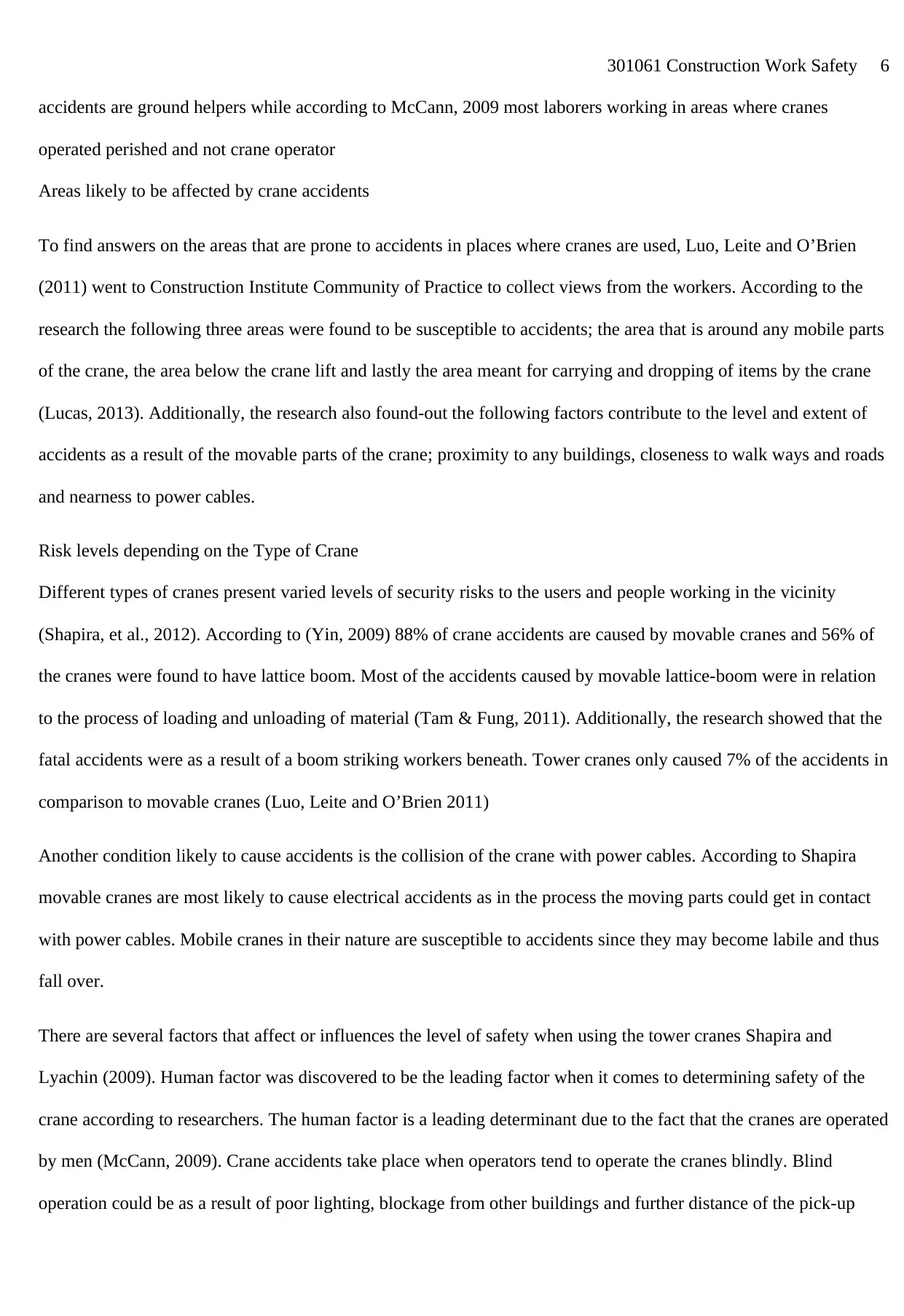
301061 Construction Work Safety 6
accidents are ground helpers while according to McCann, 2009 most laborers working in areas where cranes
operated perished and not crane operator
Areas likely to be affected by crane accidents
To find answers on the areas that are prone to accidents in places where cranes are used, Luo, Leite and O’Brien
(2011) went to Construction Institute Community of Practice to collect views from the workers. According to the
research the following three areas were found to be susceptible to accidents; the area that is around any mobile parts
of the crane, the area below the crane lift and lastly the area meant for carrying and dropping of items by the crane
(Lucas, 2013). Additionally, the research also found-out the following factors contribute to the level and extent of
accidents as a result of the movable parts of the crane; proximity to any buildings, closeness to walk ways and roads
and nearness to power cables.
Risk levels depending on the Type of Crane
Different types of cranes present varied levels of security risks to the users and people working in the vicinity
(Shapira, et al., 2012). According to (Yin, 2009) 88% of crane accidents are caused by movable cranes and 56% of
the cranes were found to have lattice boom. Most of the accidents caused by movable lattice-boom were in relation
to the process of loading and unloading of material (Tam & Fung, 2011). Additionally, the research showed that the
fatal accidents were as a result of a boom striking workers beneath. Tower cranes only caused 7% of the accidents in
comparison to movable cranes (Luo, Leite and O’Brien 2011)
Another condition likely to cause accidents is the collision of the crane with power cables. According to Shapira
movable cranes are most likely to cause electrical accidents as in the process the moving parts could get in contact
with power cables. Mobile cranes in their nature are susceptible to accidents since they may become labile and thus
fall over.
There are several factors that affect or influences the level of safety when using the tower cranes Shapira and
Lyachin (2009). Human factor was discovered to be the leading factor when it comes to determining safety of the
crane according to researchers. The human factor is a leading determinant due to the fact that the cranes are operated
by men (McCann, 2009). Crane accidents take place when operators tend to operate the cranes blindly. Blind
operation could be as a result of poor lighting, blockage from other buildings and further distance of the pick-up
accidents are ground helpers while according to McCann, 2009 most laborers working in areas where cranes
operated perished and not crane operator
Areas likely to be affected by crane accidents
To find answers on the areas that are prone to accidents in places where cranes are used, Luo, Leite and O’Brien
(2011) went to Construction Institute Community of Practice to collect views from the workers. According to the
research the following three areas were found to be susceptible to accidents; the area that is around any mobile parts
of the crane, the area below the crane lift and lastly the area meant for carrying and dropping of items by the crane
(Lucas, 2013). Additionally, the research also found-out the following factors contribute to the level and extent of
accidents as a result of the movable parts of the crane; proximity to any buildings, closeness to walk ways and roads
and nearness to power cables.
Risk levels depending on the Type of Crane
Different types of cranes present varied levels of security risks to the users and people working in the vicinity
(Shapira, et al., 2012). According to (Yin, 2009) 88% of crane accidents are caused by movable cranes and 56% of
the cranes were found to have lattice boom. Most of the accidents caused by movable lattice-boom were in relation
to the process of loading and unloading of material (Tam & Fung, 2011). Additionally, the research showed that the
fatal accidents were as a result of a boom striking workers beneath. Tower cranes only caused 7% of the accidents in
comparison to movable cranes (Luo, Leite and O’Brien 2011)
Another condition likely to cause accidents is the collision of the crane with power cables. According to Shapira
movable cranes are most likely to cause electrical accidents as in the process the moving parts could get in contact
with power cables. Mobile cranes in their nature are susceptible to accidents since they may become labile and thus
fall over.
There are several factors that affect or influences the level of safety when using the tower cranes Shapira and
Lyachin (2009). Human factor was discovered to be the leading factor when it comes to determining safety of the
crane according to researchers. The human factor is a leading determinant due to the fact that the cranes are operated
by men (McCann, 2009). Crane accidents take place when operators tend to operate the cranes blindly. Blind
operation could be as a result of poor lighting, blockage from other buildings and further distance of the pick-up
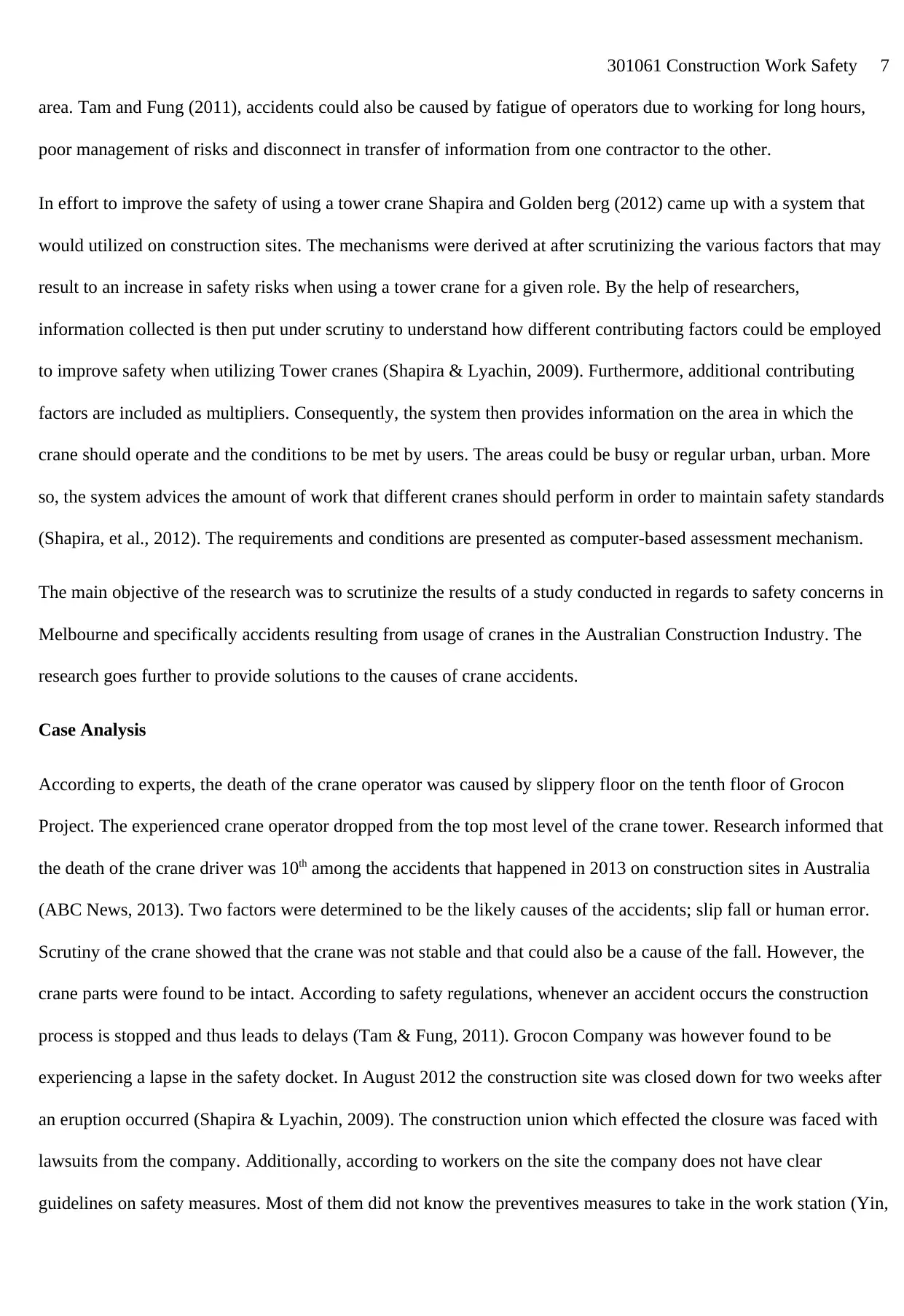
301061 Construction Work Safety 7
area. Tam and Fung (2011), accidents could also be caused by fatigue of operators due to working for long hours,
poor management of risks and disconnect in transfer of information from one contractor to the other.
In effort to improve the safety of using a tower crane Shapira and Golden berg (2012) came up with a system that
would utilized on construction sites. The mechanisms were derived at after scrutinizing the various factors that may
result to an increase in safety risks when using a tower crane for a given role. By the help of researchers,
information collected is then put under scrutiny to understand how different contributing factors could be employed
to improve safety when utilizing Tower cranes (Shapira & Lyachin, 2009). Furthermore, additional contributing
factors are included as multipliers. Consequently, the system then provides information on the area in which the
crane should operate and the conditions to be met by users. The areas could be busy or regular urban, urban. More
so, the system advices the amount of work that different cranes should perform in order to maintain safety standards
(Shapira, et al., 2012). The requirements and conditions are presented as computer-based assessment mechanism.
The main objective of the research was to scrutinize the results of a study conducted in regards to safety concerns in
Melbourne and specifically accidents resulting from usage of cranes in the Australian Construction Industry. The
research goes further to provide solutions to the causes of crane accidents.
Case Analysis
According to experts, the death of the crane operator was caused by slippery floor on the tenth floor of Grocon
Project. The experienced crane operator dropped from the top most level of the crane tower. Research informed that
the death of the crane driver was 10th among the accidents that happened in 2013 on construction sites in Australia
(ABC News, 2013). Two factors were determined to be the likely causes of the accidents; slip fall or human error.
Scrutiny of the crane showed that the crane was not stable and that could also be a cause of the fall. However, the
crane parts were found to be intact. According to safety regulations, whenever an accident occurs the construction
process is stopped and thus leads to delays (Tam & Fung, 2011). Grocon Company was however found to be
experiencing a lapse in the safety docket. In August 2012 the construction site was closed down for two weeks after
an eruption occurred (Shapira & Lyachin, 2009). The construction union which effected the closure was faced with
lawsuits from the company. Additionally, according to workers on the site the company does not have clear
guidelines on safety measures. Most of them did not know the preventives measures to take in the work station (Yin,
area. Tam and Fung (2011), accidents could also be caused by fatigue of operators due to working for long hours,
poor management of risks and disconnect in transfer of information from one contractor to the other.
In effort to improve the safety of using a tower crane Shapira and Golden berg (2012) came up with a system that
would utilized on construction sites. The mechanisms were derived at after scrutinizing the various factors that may
result to an increase in safety risks when using a tower crane for a given role. By the help of researchers,
information collected is then put under scrutiny to understand how different contributing factors could be employed
to improve safety when utilizing Tower cranes (Shapira & Lyachin, 2009). Furthermore, additional contributing
factors are included as multipliers. Consequently, the system then provides information on the area in which the
crane should operate and the conditions to be met by users. The areas could be busy or regular urban, urban. More
so, the system advices the amount of work that different cranes should perform in order to maintain safety standards
(Shapira, et al., 2012). The requirements and conditions are presented as computer-based assessment mechanism.
The main objective of the research was to scrutinize the results of a study conducted in regards to safety concerns in
Melbourne and specifically accidents resulting from usage of cranes in the Australian Construction Industry. The
research goes further to provide solutions to the causes of crane accidents.
Case Analysis
According to experts, the death of the crane operator was caused by slippery floor on the tenth floor of Grocon
Project. The experienced crane operator dropped from the top most level of the crane tower. Research informed that
the death of the crane driver was 10th among the accidents that happened in 2013 on construction sites in Australia
(ABC News, 2013). Two factors were determined to be the likely causes of the accidents; slip fall or human error.
Scrutiny of the crane showed that the crane was not stable and that could also be a cause of the fall. However, the
crane parts were found to be intact. According to safety regulations, whenever an accident occurs the construction
process is stopped and thus leads to delays (Tam & Fung, 2011). Grocon Company was however found to be
experiencing a lapse in the safety docket. In August 2012 the construction site was closed down for two weeks after
an eruption occurred (Shapira & Lyachin, 2009). The construction union which effected the closure was faced with
lawsuits from the company. Additionally, according to workers on the site the company does not have clear
guidelines on safety measures. Most of them did not know the preventives measures to take in the work station (Yin,
Paraphrase This Document
Need a fresh take? Get an instant paraphrase of this document with our AI Paraphraser
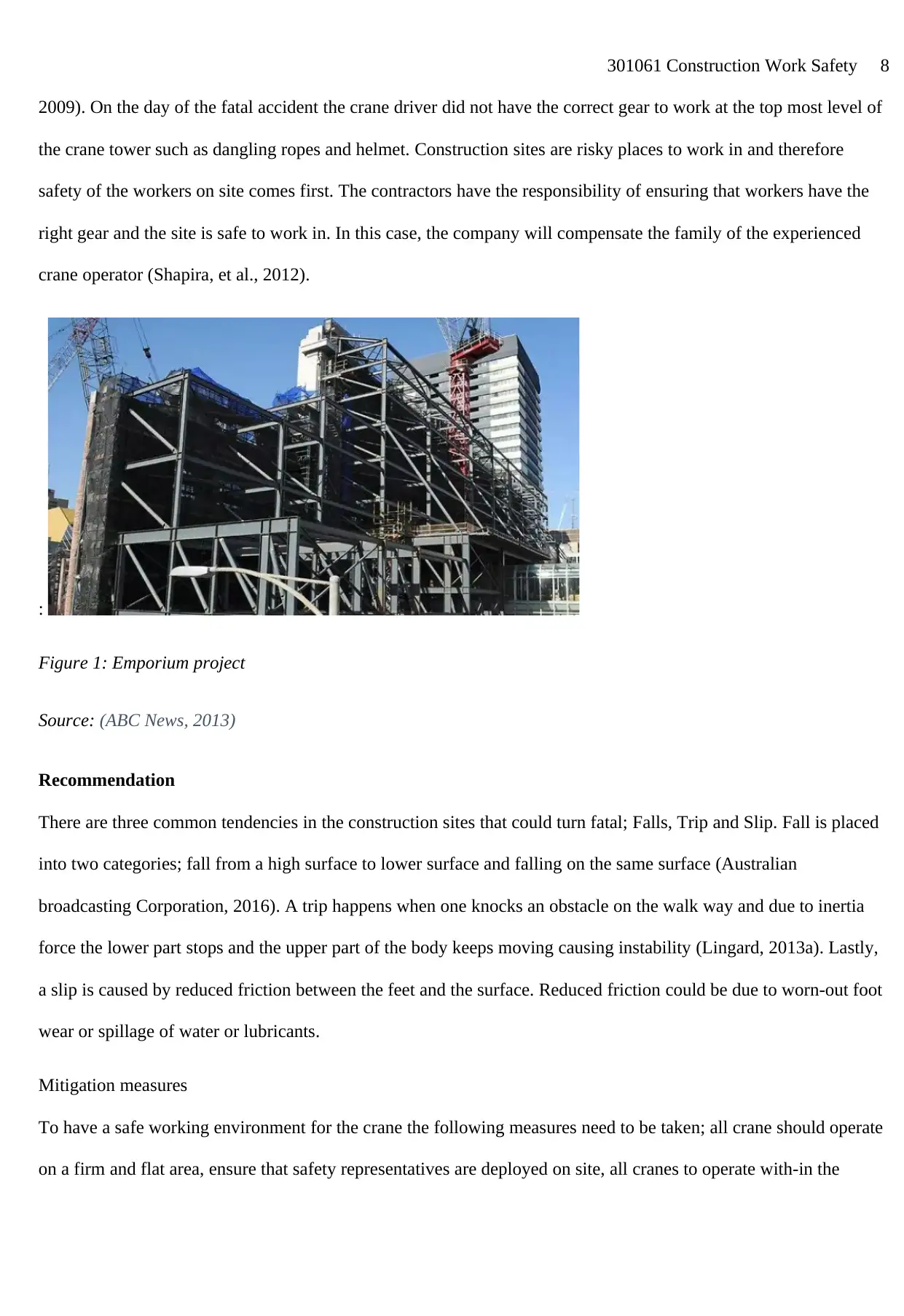
301061 Construction Work Safety 8
2009). On the day of the fatal accident the crane driver did not have the correct gear to work at the top most level of
the crane tower such as dangling ropes and helmet. Construction sites are risky places to work in and therefore
safety of the workers on site comes first. The contractors have the responsibility of ensuring that workers have the
right gear and the site is safe to work in. In this case, the company will compensate the family of the experienced
crane operator (Shapira, et al., 2012).
:
Figure 1: Emporium project
Source: (ABC News, 2013)
Recommendation
There are three common tendencies in the construction sites that could turn fatal; Falls, Trip and Slip. Fall is placed
into two categories; fall from a high surface to lower surface and falling on the same surface (Australian
broadcasting Corporation, 2016). A trip happens when one knocks an obstacle on the walk way and due to inertia
force the lower part stops and the upper part of the body keeps moving causing instability (Lingard, 2013a). Lastly,
a slip is caused by reduced friction between the feet and the surface. Reduced friction could be due to worn-out foot
wear or spillage of water or lubricants.
Mitigation measures
To have a safe working environment for the crane the following measures need to be taken; all crane should operate
on a firm and flat area, ensure that safety representatives are deployed on site, all cranes to operate with-in the
2009). On the day of the fatal accident the crane driver did not have the correct gear to work at the top most level of
the crane tower such as dangling ropes and helmet. Construction sites are risky places to work in and therefore
safety of the workers on site comes first. The contractors have the responsibility of ensuring that workers have the
right gear and the site is safe to work in. In this case, the company will compensate the family of the experienced
crane operator (Shapira, et al., 2012).
:
Figure 1: Emporium project
Source: (ABC News, 2013)
Recommendation
There are three common tendencies in the construction sites that could turn fatal; Falls, Trip and Slip. Fall is placed
into two categories; fall from a high surface to lower surface and falling on the same surface (Australian
broadcasting Corporation, 2016). A trip happens when one knocks an obstacle on the walk way and due to inertia
force the lower part stops and the upper part of the body keeps moving causing instability (Lingard, 2013a). Lastly,
a slip is caused by reduced friction between the feet and the surface. Reduced friction could be due to worn-out foot
wear or spillage of water or lubricants.
Mitigation measures
To have a safe working environment for the crane the following measures need to be taken; all crane should operate
on a firm and flat area, ensure that safety representatives are deployed on site, all cranes to operate with-in the
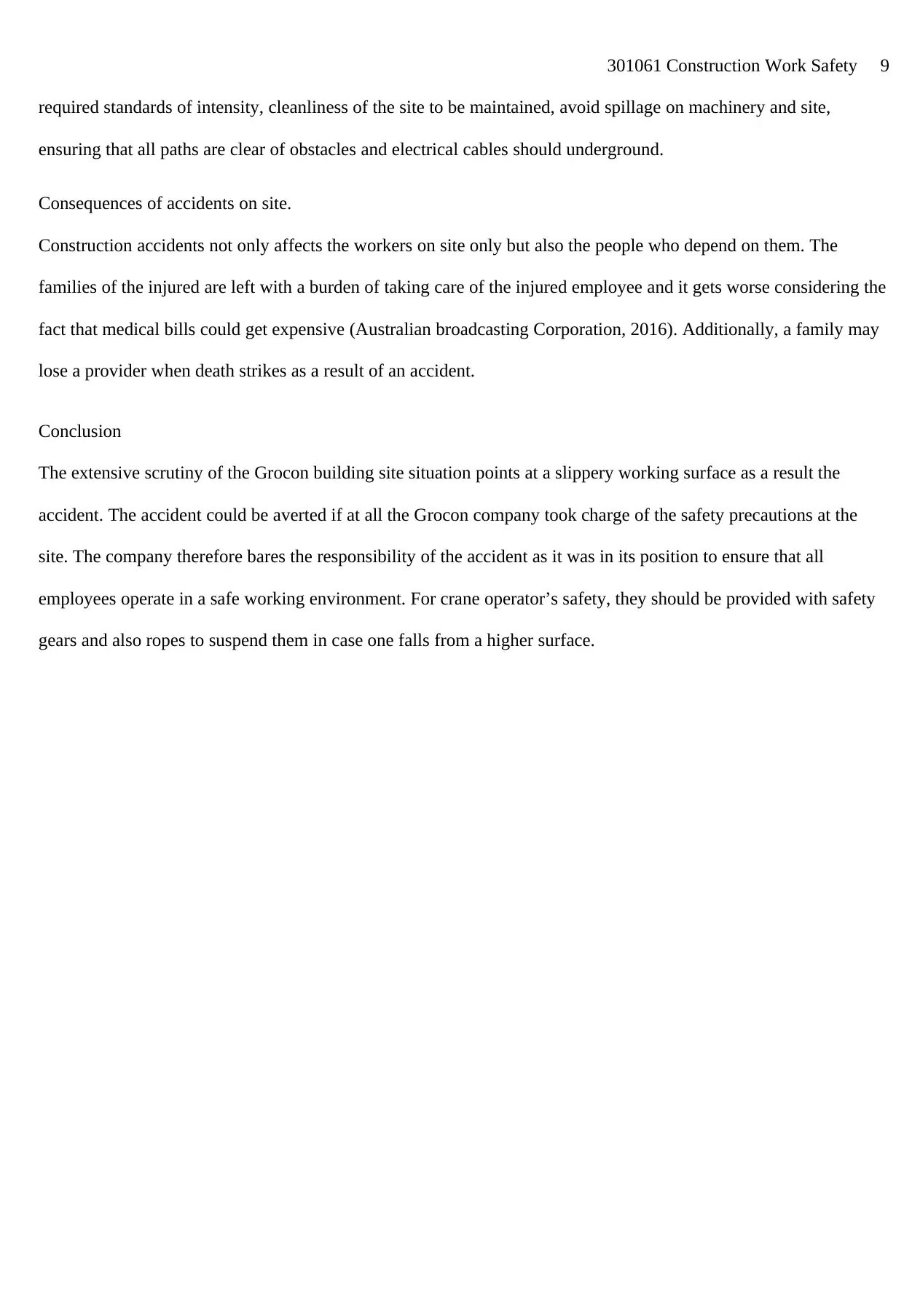
301061 Construction Work Safety 9
required standards of intensity, cleanliness of the site to be maintained, avoid spillage on machinery and site,
ensuring that all paths are clear of obstacles and electrical cables should underground.
Consequences of accidents on site.
Construction accidents not only affects the workers on site only but also the people who depend on them. The
families of the injured are left with a burden of taking care of the injured employee and it gets worse considering the
fact that medical bills could get expensive (Australian broadcasting Corporation, 2016). Additionally, a family may
lose a provider when death strikes as a result of an accident.
Conclusion
The extensive scrutiny of the Grocon building site situation points at a slippery working surface as a result the
accident. The accident could be averted if at all the Grocon company took charge of the safety precautions at the
site. The company therefore bares the responsibility of the accident as it was in its position to ensure that all
employees operate in a safe working environment. For crane operator’s safety, they should be provided with safety
gears and also ropes to suspend them in case one falls from a higher surface.
required standards of intensity, cleanliness of the site to be maintained, avoid spillage on machinery and site,
ensuring that all paths are clear of obstacles and electrical cables should underground.
Consequences of accidents on site.
Construction accidents not only affects the workers on site only but also the people who depend on them. The
families of the injured are left with a burden of taking care of the injured employee and it gets worse considering the
fact that medical bills could get expensive (Australian broadcasting Corporation, 2016). Additionally, a family may
lose a provider when death strikes as a result of an accident.
Conclusion
The extensive scrutiny of the Grocon building site situation points at a slippery working surface as a result the
accident. The accident could be averted if at all the Grocon company took charge of the safety precautions at the
site. The company therefore bares the responsibility of the accident as it was in its position to ensure that all
employees operate in a safe working environment. For crane operator’s safety, they should be provided with safety
gears and also ropes to suspend them in case one falls from a higher surface.
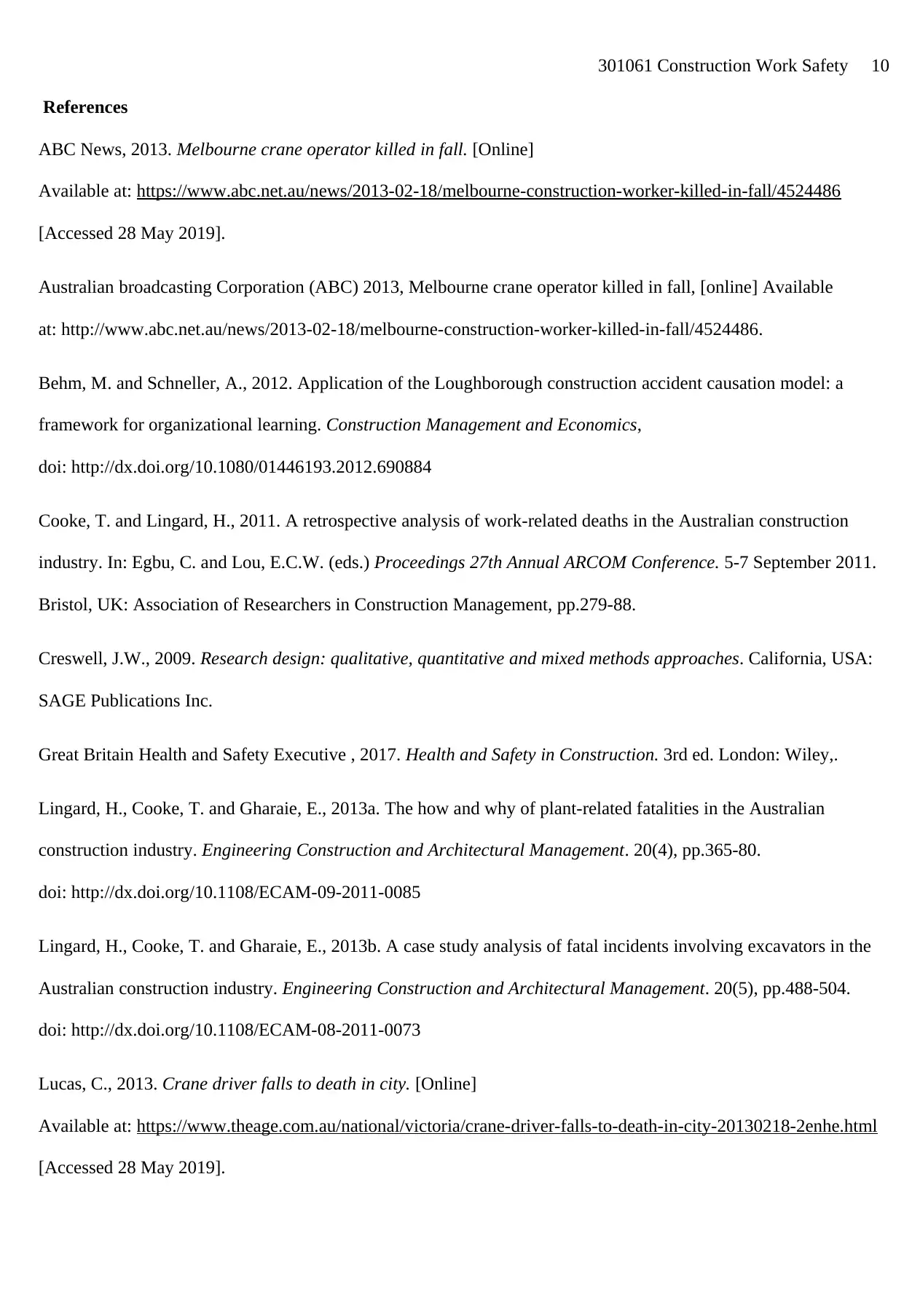
301061 Construction Work Safety 10
References
ABC News, 2013. Melbourne crane operator killed in fall. [Online]
Available at: https://www.abc.net.au/news/2013-02-18/melbourne-construction-worker-killed-in-fall/4524486
[Accessed 28 May 2019].
Australian broadcasting Corporation (ABC) 2013, Melbourne crane operator killed in fall, [online] Available
at: http://www.abc.net.au/news/2013-02-18/melbourne-construction-worker-killed-in-fall/4524486.
Behm, M. and Schneller, A., 2012. Application of the Loughborough construction accident causation model: a
framework for organizational learning. Construction Management and Economics,
doi: http://dx.doi.org/10.1080/01446193.2012.690884
Cooke, T. and Lingard, H., 2011. A retrospective analysis of work-related deaths in the Australian construction
industry. In: Egbu, C. and Lou, E.C.W. (eds.) Proceedings 27th Annual ARCOM Conference. 5-7 September 2011.
Bristol, UK: Association of Researchers in Construction Management, pp.279-88.
Creswell, J.W., 2009. Research design: qualitative, quantitative and mixed methods approaches. California, USA:
SAGE Publications Inc.
Great Britain Health and Safety Executive , 2017. Health and Safety in Construction. 3rd ed. London: Wiley,.
Lingard, H., Cooke, T. and Gharaie, E., 2013a. The how and why of plant-related fatalities in the Australian
construction industry. Engineering Construction and Architectural Management. 20(4), pp.365-80.
doi: http://dx.doi.org/10.1108/ECAM-09-2011-0085
Lingard, H., Cooke, T. and Gharaie, E., 2013b. A case study analysis of fatal incidents involving excavators in the
Australian construction industry. Engineering Construction and Architectural Management. 20(5), pp.488-504.
doi: http://dx.doi.org/10.1108/ECAM-08-2011-0073
Lucas, C., 2013. Crane driver falls to death in city. [Online]
Available at: https://www.theage.com.au/national/victoria/crane-driver-falls-to-death-in-city-20130218-2enhe.html
[Accessed 28 May 2019].
References
ABC News, 2013. Melbourne crane operator killed in fall. [Online]
Available at: https://www.abc.net.au/news/2013-02-18/melbourne-construction-worker-killed-in-fall/4524486
[Accessed 28 May 2019].
Australian broadcasting Corporation (ABC) 2013, Melbourne crane operator killed in fall, [online] Available
at: http://www.abc.net.au/news/2013-02-18/melbourne-construction-worker-killed-in-fall/4524486.
Behm, M. and Schneller, A., 2012. Application of the Loughborough construction accident causation model: a
framework for organizational learning. Construction Management and Economics,
doi: http://dx.doi.org/10.1080/01446193.2012.690884
Cooke, T. and Lingard, H., 2011. A retrospective analysis of work-related deaths in the Australian construction
industry. In: Egbu, C. and Lou, E.C.W. (eds.) Proceedings 27th Annual ARCOM Conference. 5-7 September 2011.
Bristol, UK: Association of Researchers in Construction Management, pp.279-88.
Creswell, J.W., 2009. Research design: qualitative, quantitative and mixed methods approaches. California, USA:
SAGE Publications Inc.
Great Britain Health and Safety Executive , 2017. Health and Safety in Construction. 3rd ed. London: Wiley,.
Lingard, H., Cooke, T. and Gharaie, E., 2013a. The how and why of plant-related fatalities in the Australian
construction industry. Engineering Construction and Architectural Management. 20(4), pp.365-80.
doi: http://dx.doi.org/10.1108/ECAM-09-2011-0085
Lingard, H., Cooke, T. and Gharaie, E., 2013b. A case study analysis of fatal incidents involving excavators in the
Australian construction industry. Engineering Construction and Architectural Management. 20(5), pp.488-504.
doi: http://dx.doi.org/10.1108/ECAM-08-2011-0073
Lucas, C., 2013. Crane driver falls to death in city. [Online]
Available at: https://www.theage.com.au/national/victoria/crane-driver-falls-to-death-in-city-20130218-2enhe.html
[Accessed 28 May 2019].
Secure Best Marks with AI Grader
Need help grading? Try our AI Grader for instant feedback on your assignments.
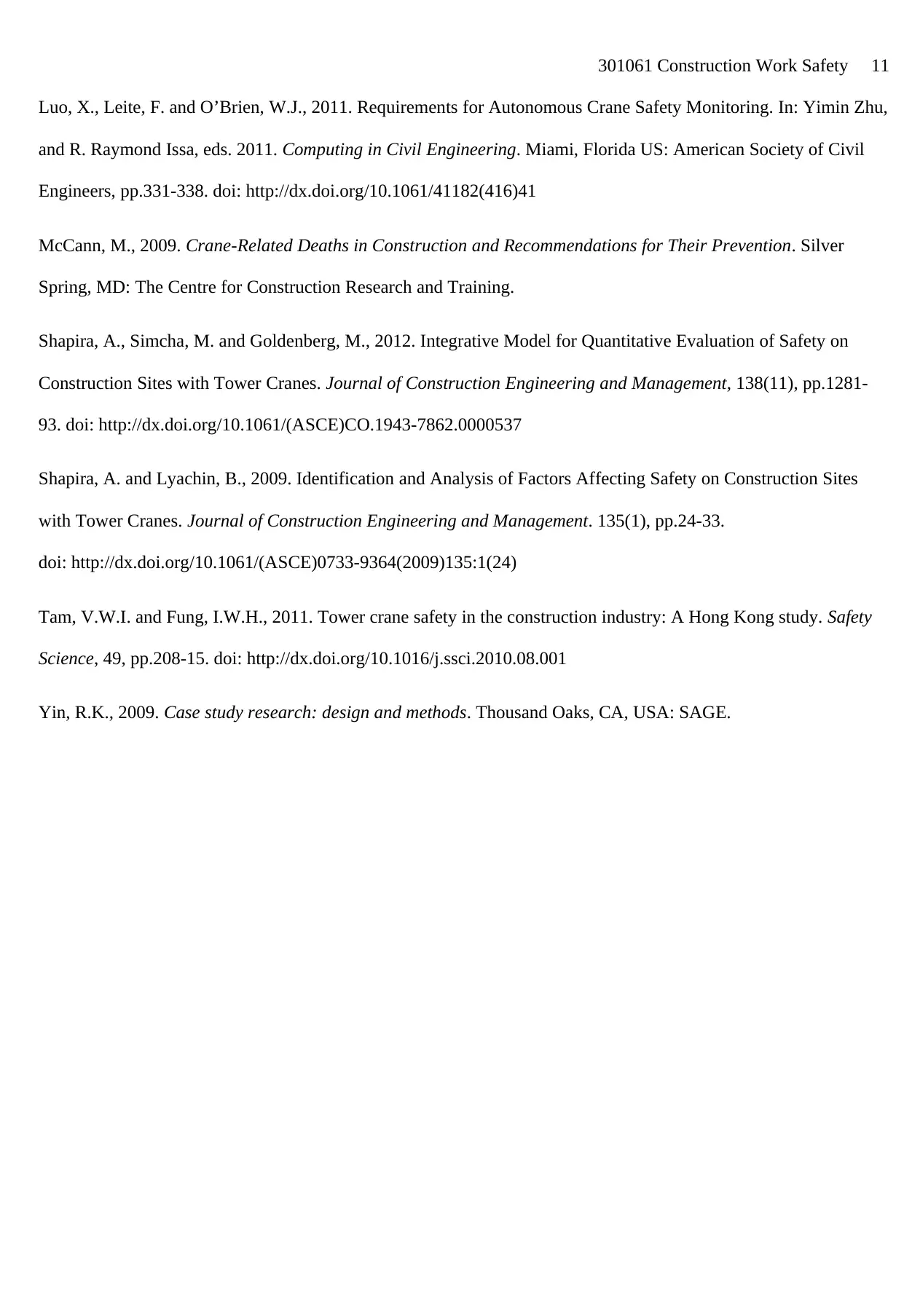
301061 Construction Work Safety 11
Luo, X., Leite, F. and O’Brien, W.J., 2011. Requirements for Autonomous Crane Safety Monitoring. In: Yimin Zhu,
and R. Raymond Issa, eds. 2011. Computing in Civil Engineering. Miami, Florida US: American Society of Civil
Engineers, pp.331-338. doi: http://dx.doi.org/10.1061/41182(416)41
McCann, M., 2009. Crane-Related Deaths in Construction and Recommendations for Their Prevention. Silver
Spring, MD: The Centre for Construction Research and Training.
Shapira, A., Simcha, M. and Goldenberg, M., 2012. Integrative Model for Quantitative Evaluation of Safety on
Construction Sites with Tower Cranes. Journal of Construction Engineering and Management, 138(11), pp.1281-
93. doi: http://dx.doi.org/10.1061/(ASCE)CO.1943-7862.0000537
Shapira, A. and Lyachin, B., 2009. Identification and Analysis of Factors Affecting Safety on Construction Sites
with Tower Cranes. Journal of Construction Engineering and Management. 135(1), pp.24-33.
doi: http://dx.doi.org/10.1061/(ASCE)0733-9364(2009)135:1(24)
Tam, V.W.I. and Fung, I.W.H., 2011. Tower crane safety in the construction industry: A Hong Kong study. Safety
Science, 49, pp.208-15. doi: http://dx.doi.org/10.1016/j.ssci.2010.08.001
Yin, R.K., 2009. Case study research: design and methods. Thousand Oaks, CA, USA: SAGE.
Luo, X., Leite, F. and O’Brien, W.J., 2011. Requirements for Autonomous Crane Safety Monitoring. In: Yimin Zhu,
and R. Raymond Issa, eds. 2011. Computing in Civil Engineering. Miami, Florida US: American Society of Civil
Engineers, pp.331-338. doi: http://dx.doi.org/10.1061/41182(416)41
McCann, M., 2009. Crane-Related Deaths in Construction and Recommendations for Their Prevention. Silver
Spring, MD: The Centre for Construction Research and Training.
Shapira, A., Simcha, M. and Goldenberg, M., 2012. Integrative Model for Quantitative Evaluation of Safety on
Construction Sites with Tower Cranes. Journal of Construction Engineering and Management, 138(11), pp.1281-
93. doi: http://dx.doi.org/10.1061/(ASCE)CO.1943-7862.0000537
Shapira, A. and Lyachin, B., 2009. Identification and Analysis of Factors Affecting Safety on Construction Sites
with Tower Cranes. Journal of Construction Engineering and Management. 135(1), pp.24-33.
doi: http://dx.doi.org/10.1061/(ASCE)0733-9364(2009)135:1(24)
Tam, V.W.I. and Fung, I.W.H., 2011. Tower crane safety in the construction industry: A Hong Kong study. Safety
Science, 49, pp.208-15. doi: http://dx.doi.org/10.1016/j.ssci.2010.08.001
Yin, R.K., 2009. Case study research: design and methods. Thousand Oaks, CA, USA: SAGE.
1 out of 11
Related Documents
Your All-in-One AI-Powered Toolkit for Academic Success.
+13062052269
info@desklib.com
Available 24*7 on WhatsApp / Email
![[object Object]](/_next/static/media/star-bottom.7253800d.svg)
Unlock your academic potential
© 2024 | Zucol Services PVT LTD | All rights reserved.




